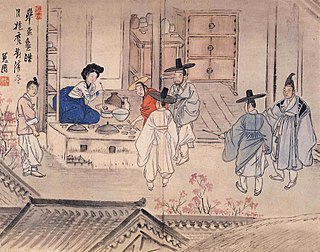| Grains | Name of fermented beverage | Name of distilled beverage |
|---|
| Barley | beer, barley wine | gin, Scotch whisky, Irish whiskey, jenever (Central Europe), ginebra (Spain, Argentina, Philippines), shōchū (mugijōchū) (Japan), soju (Korea), baijiu (China) |
| Buckwheat | | buckwheat whisky (Brittany), shōchū (sobajōchū) (Japan) |
| Corn | chicha, corn beer, tesguino | bourbon whiskey, moonshine, also vodka (rare) |
| Millet | millet beer (Sub-Saharan Africa), tongba (Nepal), boza (the Balkans, Turkey) | |
| Rice | beer, brem (Indonesia), ruou gao (Vietnam), tuak (Borneo Island), sato (Thailand), huangjiu and choujiu (China), sake (Japan), makgeolli and cheongju (Korea), sonti, handia, and chuak (India), thwon (Nepal) | aila (Nepal), rice baijiu (China), shōchū (komejōchū) and awamori (Japan), soju (Korea), hkaung rai (Myanmar), arrack (Indonesia), lao khao (Thailand) |
| Rye | rye beer, kvass | rye whiskey, vodka (Russia), korn (Germany) |
| Sorghum | burukutu (Nigeria), pito (Ghana), merisa (southern Sudan), bilibili (Chad, Central African Republic, Cameroon) | Maotai, Kaoliang liquor, certain other types of baijiu (China). |
| Wheat | wheat beer | horilka (Ukraine), vodka, wheat whiskey, weizenkorn (Germany), soju (Korea) |
| Fruit juice | Name of fermented beverage | Name of distilled beverage |
|---|
| Apples | cider (U.S.: "hard cider"), apfelwein | jabukovača (Serbia), applejack (or apple brandy), calvados, cider |
| Apricots | | kajsijevača (Serbia), kaisieva rakia (Bulgaria), pálinka (Hungary) |
| Bananas or plantains | chuoi hot (Vietnam), cauim (Kuna Indians of Panama), urgwagwa (Uganda, Rwanda), mbege (with millet malt; Tanzania), kasikisi (with sorghum malt; Democratic Republic of the Congo) | majmunovača (Balkans) |
| Blueberries | | borovnica (Croatia) |
| Cashews | | feni (India) |
| Cherries | cherry wine (Denmark) | Kirsch (Germany, Switzerland) |
| Coconuts or palm | palm wine | arrack, lambanog (Sri Lanka, India, Philippines) |
| Gouqi | gouqi jiu (China) | gouqi jiu (China) |
| Ginger with sugar, ginger with raisins | ginger ale, ginger beer, ginger wine | |
| Grapes | wine, Cachina (Perú) | brandy, cognac (France), vermouth, armagnac (France), branntwein (Germany), pisco (Peru), rakija (The Balkans, Turkey), singani (Bolivia), arak (Syria, Lebanon, Jordan), törkölypálinka (Hungary), zivania (Cyprus) |
| Juniper berries | | gin, jenever (Netherlands/Belgium), borovička (Slovakia) |
| Mulberries | | oghi (Armenia) |
| Myrica rubra | yangmei jiu (China) | yangmei jiu (China) |
| Pears | perry, or pear cider; poiré (France) | kruškovac (Croatia), viljamovka (Serbia), Poire Williams, pear brandy, eau-de-vie (France), pálinka (Hungary), krushova rakia / krushevitsa (Bulgaria) |
| Pineapples | tepache (Mexico), Pineapple Wine (Hawaii) | |
| Plums | plum wine, plum jerkum | šljivovica (Balkans and Central Europe), slivovitz, țuică, umeshu (Japan), pálinka, slivova rakia / slivovitsa (Bulgaria) |
| Pomace | pomace wine | raki/ouzo/pastis/sambuca (Turkey/Greece/France/Italy), tsipouro/tsikoudia (Greece), grappa (Italy/Argentina/Uruguay), trester (Germany), marc (France), orujo (Spain), zivania (Cyprus), bagaço (Portugal), tescovină (Romania), arak (Iran) |
| Pomegranates | pomegranate wine (Armenia) | |
| Quinces | | dunjevača (Serbia) |
| Raspberries | raspberry wine [2] (US, Canada) | Himbeergeist (Germany, Switzerland) |
|
| Sausage tree fruit | muratina wine [3] (Kenya) | |
| Flowers | Name of fermented beverage | Name of distilled beverage |
|---|
| Madhuca longifolia | mahudo and mahuda no daru (Gujarat), mahuva ki sharaab, madhvi, and tharra (Madhya Pradesh, Chhattisgarh) | |
| Vegetables | Name of fermented beverage | Name of distilled beverage |
|---|
| Agave juice | | tequila, mezcal, raicilla, bacanora |
| Agave sap | pulque | |
| Cassava | Saliva-fermented beverages: - cauim
- chicha: Throughout the Amazon Basin, including the interiors of Brazil, Ecuador, Peru, and Venezuela, chicha is made most often with cassava; in Peruvian Amazonia chichia is known as masato .
- kasiri (Sub-Saharan Africa)
- nihamanchi (South America) a.k.a. nijimanche (Ecuador and Peru)
- parakari (Guyana)
- sakurá (Brazil, Surinam)
| tiquira (Brazil) |
| Ginger root juice | ginger beer (Botswana) | |
| Potato | potato beer | horilka (Ukraine), vodka (Poland), Kartoffelschnaps (Germany), akvavit (Scandinavia), poitín (poteen) (Ireland), tuzemák (Czech Republic), brennivín (Iceland) |
| Sugarcane juice, or molasses | basi, betsa-betsa (regional) | rum (Caribbean), rhum agricole (Haiti, Martinique, Guadeloupe and the rest of the French Caribbean), clairin (Haiti), cachaça (Brazil), desi daru (India), aguardiente de caña (Spain), aguardiente, guaro, lavagallo, pinga (Venezuela, Colombia, Nicaragua), mamajuana (Dominican Republic), gongo and konyagi (Tanzania), cocoroco (Bolivia), caña (Argentina, Uruguay), espinillar (Uruguay), caña blanca (Paraguay), ginebra (Philippines) |
| Sweet potato | | shōchū (imojōchū) (Japan), soju (Korea) |
| Ti root | | okolehao (Hawai'i) |
| Other raw materials | Name of fermented beverage | Name of distilled beverage |
|---|
| Sap of palm | coyol wine (Central America), tembo (Sub-Saharan Africa), toddy (Indian subcontinent), namtanmao (Thailand) | |
| Sap of Arenga pinnata, coconut, Borassus flabellifer | palm wine, tubâ (Philippines), namtanmao (Thailand) | arrack, lambanog (Philippines) |
| Honey | mead, horilka (Ukraine), sima (Finland), tej (Ethiopia) | medica (Croatia), distilled mead, honey-flavored liqueur |
| Milk | kumis, kefir, blaand | arkhi (Mongolia) |
| Sugar | kilju (Finland) | shōchū (kokutō shōchū): made from brown sugar (Japan) or rum |
| Walnuts | | orahovac (Croatia, Serbia) |


















